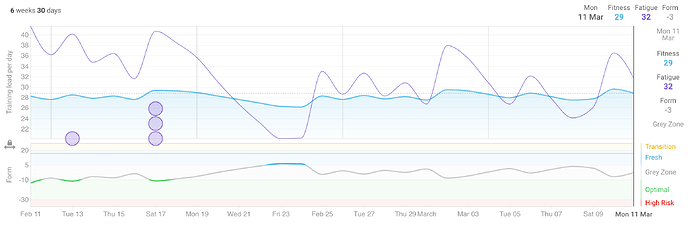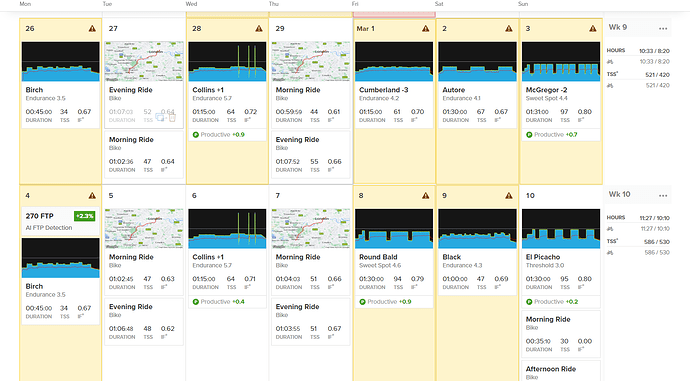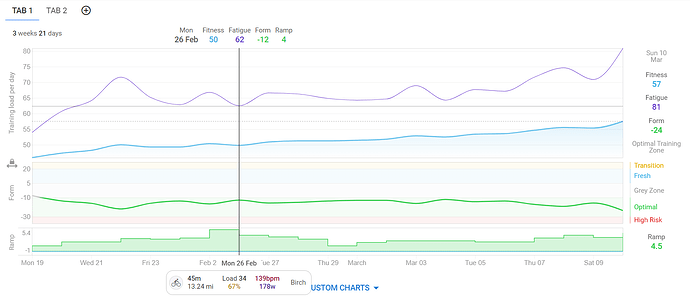Just noticed there are 5 different levels of training aggressiveness, thought there were only 3. Cue me cycling between all 5 after every workout to see how each recommends adaptations.
I’ve named the step between Balanced and Aggressive: Ambitious
So it’s been interesting to track RLGL vs. intervals.icu vs. Garmin, etc. and how each are trying to guide my training status and intensity.
Case in point, it seems that RLGL and the fitness tracking on intervals.icu are offering me someone contradictory guidance – if I follow RLGL it keeps me solidly in the grey zone on intervals.icu. If I push myself into the green zone, then RLGL tells me I’m overtraining.
Curious how others make sure they’re progressing at the appropriate rate, and which data inputs you find most useful to that end.
I was just reflecting on this this week too. For me at least, I’ve found this new RLGL more accurate than using “fatigue.”
Ex: 4 week build and intervals had me in the red basically the whole time. I felt fine though and RLGL flagged nothing even as yellow. I had three yellows in a row at the very end before a recovery week, and on the last one I had hit the feeling of nonproductive training, so eagerly hit that recovery week.
Ex: coming off the recovery week I did a 3h endurance ride (PL~7.x). Felt fine during and after it. RLGL made my next day a red day and recommended rest. I thought I felt fine so ignored it. Was in the grey on intervals. Woke up the next day and realized I was not actually good (surprisingly) and just did recovery spin instead.
So, so far, I’ve found it to be more accurate than TSS-based fatigue measurements. It tends to gel well with what I’m actually feeling. And seems to maybe pick up in signals ahead of time that I’m not even noticing yet. So it’s definitely adding an independent data point that I’ve found useful to synthesize into everything else so far.
Thanks for sharing. That’s really interesting to hear.
I think both RLGL and the form% chart on intervals look at your volume and CTL over the previous couple of weeks.
I have found that RLGL starts giving me yellow days when form starts dipping below -20 on intervals. The rest of the time it stays in the optimal range most of the time. I have also been finding RLGL to be more responsive to yellow or red days as opposed to just looking at the form% chart and trying to interpret if you feel too fatigued or overtrained even if the chart doesn’t show you are. One more thing to mention is that I did move the training aggressiveness meter one notch to the right.
I’m still tracking both and looking at correlations but so far it appears RLGL is working pretty well in my opinion.
So here’s a snapshot of where I’m at today. Reminder, I’m a historical LV user trying to move up to MV. I’ve got a red light for today, but if I don’t keep training each day, I’m having a really hard time increasing my form to -10 and below (aka. green zone vs. the dreaded "grey zone of non-productivity).
Again, a bit of an interesting tug of war as far as whose guidance is most on the mark. I’m giving the nod to RLGL today – my legs feel tired.
I recall Nate clearly stating that RLGL isn’t simply a re-configuration of CTL, TSS, etc. So similar in concept, but different in execution.
It remains early days. I’ve gone for the ‘add LV plan and add volume’ approach and just finised the first base phase using RLGL.
It has been a bit of a dance to keep from being red carded, keep the yellows at bay and to get the few intense workouts done (or swapped out!). I’ve found my motivation to be much higher than expected, and it has in my opinion done a decent job at steering that in a few ways:
- Reduced the number of intense workouts. Some weeks had 3, others 1.
- Encouraged more discipline on the commutes, keep it chill for the trainer sessions.
- Given confidence to pack in more endurace and ride 6 or 7 days a week.
Some early FTP bumps are a nice treat, but hitting build is where things will get interesting and also how it helps in dealing with more distraction for outside rides as Spring/Summer arrives.
For reference, here is the full 3 weeks on intervals.icu, with the line marking the 2 weeks above.
p.s. I dialled this up. Have the time and space to attempt to eat and sleep well.
Where do I do this?
I feel like running is over emphasis in RLGL. I usually run the same day I ride, and mostly easy.
And most of the time, after my morning workout, I have the next day green.
But adding a 45min light jog at noon with 107 (!!) average HR, triggers a yellow day for the next day. How’s that possible ?
I wonder if RLGL uses running power?
Well I doubt it. As far as I know TR doesnt us running power at all for anything.
And for what it is worth… running power isn’t a thing anyone uses. We use date pace/race pace, goal pace, etc.
And this might be incorrect but different running power meter readings / devices vary significantly depending on the device and algorithms.
I know a few people that use running power meters and I’m sorry to say they are poor runners… it is like they are looking for a magic answer.
The basics work well and havent been superceded yet.
Power is likely more useful to “poor runners” than pace is.
But this is OT.
Maybe.
The level just below seriously good runners also seem to use them.
I think is more its more like an attempt to make a breakthough. (other factors, that need to be addressed, overlooked, for an easier fix, I’ll spend money on the problem, only a financial
investment, no a work it out investment, harder, imo)
Certainly can be, and yes human behaviour is evolved to find the ‘easiest’ solution.
I think fundamentally power is a better measure for guiding training than pace or heart rate. And for running in particular where weight and gradient is so variable and impactful.
If all of your runners are slim and running track or flat roads, then that benefit over pace and HR evaporates.
The fact that it’s currently individual and not comparable across athletes is fine, as I have regarded bike power the same way since I started with it.
Fact is that consistent training is tricky, and the better we get at guiding people to train easy when easy and hard when hard the better so for that reason I see the future in running power.
HR takes this into consideration, internal stress is key. No need the reinvent the wheel.
Every since I signed up for red light, green light early access, my open in app button quit working




